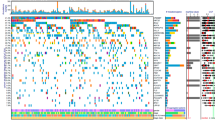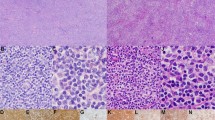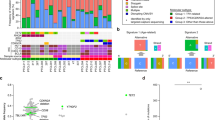Abstract
Depending on disease stage follicular lymphoma (FL) lack the t(14;18) in ~15–~50% of cases. Nevertheless, most of these cases express BCL2. To elucidate mechanisms triggering BCL2 expression and promoting pathogenesis in t(14;18)-negative FL, exonic single-nucleotide variant (SNV) profiles of 28 t(14;18)-positive and 13 t(14;18)-negative FL were analyzed, followed by the integration of copy-number changes, copy-neutral LOH and published gene-expression data as well as the assessment of immunoglobulin N-glycosylation sites. Typical FL mutations also affected t(14;18)-negative FL. Curated gene set/pathway annotation of genes mutated in either t(14;18)-positive or t(14;18)-negative FL revealed a strong enrichment of same or similar gene sets but also a more prominent or exclusive enrichment of immune response and N-glycosylation signatures in t(14;18)-negative FL. Mutated genes showed high BCL2 association in both subgroups. Among the genes mutated in t(14;18)-negative FL 555 were affected by copy-number alterations and/or copy-neutral LOH and 96 were differently expressed between t(14;18)-positive and t(14;18)-negative FL (P<0.01). N-glycosylation sites were detected considerably less frequently in t(14;18)-negative FL. These results suggest a diverse portfolio of genetic alterations that may induce or regulate BCL2 expression or promote pathogenesis of t(14;18)-negative FL as well as a less specific but increased crosstalk with the microenvironment that may compensate for the lack of N-glycosylation.
This is a preview of subscription content, access via your institution
Access options
Subscribe to this journal
Receive 12 print issues and online access
$259.00 per year
only $21.58 per issue
Buy this article
- Purchase on Springer Link
- Instant access to full article PDF
Prices may be subject to local taxes which are calculated during checkout




Similar content being viewed by others
Change history
24 May 2018
At the time of publication the Supplementary Tables 2-7 and 8-14 were omitted from the article – this has now been corrected in the HTML, the PDF was correct at the time of publication.
References
Harris NL, Swerdlow SH, Jaffe ES, Ott G. Follicular lymphoma. In: Swerdlow S, Campo E, Harris NL, Jaffe ES, PileriS, Stein H et al. (eds). WHO Classification of Tumors of Haematopoietic and Lymphoid Tissues. IARC: Lyon, 2008, pp 220–226.
Horsman DE, Okamoto I, Ludkovski O, Le N, Harder L, Gesk S et al. Follicular lymphoma lacking the t(14;18)(q32;q21): identification of two disease subtypes. Br J Haematol 2003; 120: 424–433.
Leich E, Hoster E, Wartenberg M, Unterhalt M, Siebert R, Koch K et al. Similar clinical features in follicular lymphomas with and without breaks in the BCL2 locus. Leukemia 2016; 30: 854–860.
Leich E, Salaverria I, Bea S, Zettl A, Wright G, Moreno V et al. Follicular lymphomas with and without translocation t(14;18) differ in gene expression profiles and genetic alterations. Blood 2009; 114: 826–834.
Leich E, Zamo A, Horn H, Haralambieva E, Puppe B, Gascoyne RD et al. MicroRNA profiles of t(14;18)-negative follicular lymphoma support a late germinal center B-cell phenotype. Blood 2011; 118: 5550–5558.
Kridel R, Mottok A, Farinha P, Ben-Neriah S, Ennishi D, Zheng Y et al. Cell of origin of transformed follicular lymphoma. Blood 2015; 126: 2118–2127.
Kridel R, Sehn LH, Gascoyne RD . Pathogenesis of follicular lymphoma. J Clin Invest 2012; 122: 3424–3431.
Pastore A, Jurinovic V, Kridel R, Hoster E, Staiger AM, Szczepanowski M et al. Integration of gene mutations in risk prognostication for patients receiving first-line immunochemotherapy for follicular lymphoma: a retrospective analysis of a prospective clinical trial and validation in a population-based registry. Lancet Oncol 2015; 16: 1111–1122.
Coelho V, Krysov S, Ghaemmaghami AM, Emara M, Potter KN, Johnson P et al. Glycosylation of surface Ig creates a functional bridge between human follicular lymphoma and microenvironmental lectins. Proc Natl Acad Sci USA 2010; 107: 18587–18592.
Linley A, Krysov S, Ponzoni M, Johnson PW, Packham G, Stevenson FK . Lectin binding to surface Ig variable regions provides a universal persistent activating signal for follicular lymphoma cells. Blood 2015; 126: 1902–1910.
McCann KJ, Ottensmeier CH, Callard A, Radcliffe CM, Harvey DJ, Dwek RA et al. Remarkable selective glycosylation of the immunoglobulin variable region in follicular lymphoma. Mol Immunol 2008; 45: 1567–1572.
Zhu D, McCarthy H, Ottensmeier CH, Johnson P, Hamblin TJ, Stevenson FK . Acquisition of potential N-glycosylation sites in the immunoglobulin variable region by somatic mutation is a distinctive feature of follicular lymphoma. Blood 2002; 99: 2562–2568.
Haralambieva E, Kleiverda K, Mason DY, Schuuring E, Kluin PM . Detection of three common translocation breakpoints in non-Hodgkin's lymphomas by fluorescence in situ hybridization on routine paraffin-embedded tissue sections. J Pathol 2002; 198: 163–170.
Ventura RA, Martin-Subero JI, Jones M, McParland J, Gesk S, Mason DY et al. FISH analysis for the detection of lymphoma-associated chromosomal abnormalities in routine paraffin-embedded tissue. J Mol Diagn 2006; 8: 141–151.
Lin P, Jetly R, Lennon PA, Abruzzo LV, Prajapati S, Medeiros LJ . Translocation (18;22)(q21;q11) in B-cell lymphomas: a report of 4 cases and review of the literature. Hum Pathol 2008; 39: 1664–1672.
Richter J, Schlesner M, Hoffmann S, Kreuz M, Leich E, Burkhardt B et al. Recurrent mutation of the ID3 gene in Burkitt lymphoma identified by integrated genome, exome and transcriptome sequencing. Nat Genet 2012; 44: 1316–1320.
Dave SS, Wright G, Tan B, Rosenwald A, Gascoyne RD, Chan WC et al. Prediction of survival in follicular lymphoma based on molecular features of tumor-infiltrating immune cells. N Engl J Med 2004; 351: 2159–2169.
Subramanian A, Tamayo P, Mootha VK, Mukherjee S, Ebert BL, Gillette MA et al. Gene set enrichment analysis: a knowledge-based approach for interpreting genome-wide expression profiles. Proc Natl Acad Sci USA 2005; 102: 15545–15550.
Szklarczyk D, Franceschini A, Wyder S, Forslund K, Heller D, Huerta-Cepas J et al. STRING v10: protein-protein interaction networks, integrated over the tree of life. Nucleic Acids Res 2015; 43 (Database issue): D447–D452.
Mudunuri U, Che A, Yi M, Stephens RM . bioDBnet: the biological database network. Bioinformatics 2009; 25: 555–556.
Eisen MB, Spellman PT, Brown PO, Botstein D . Cluster analysis and display of genome-wide expression patterns. Proc Natl Acad Sci USA 1998; 95: 14863–14868.
Green MR, Gentles AJ, Nair RV, Irish JM, Kihira S, Liu CL et al. Hierarchy in somatic mutations arising during genomic evolution and progression of follicular lymphoma. Blood 2013; 121: 1604–1611.
Karube K, Martinez D, Royo C, Navarro A, Pinyol M, Cazorla M et al. Recurrent mutations of NOTCH genes in follicular lymphoma identify a distinctive subset of tumours. J Pathol 2014; 234: 423–430.
Li H, Kaminski MS, Li Y, Yildiz M, Ouillette P, Jones S et al. Mutations in linker histone genes HIST1H1 B, C, D, and E; OCT2 (POU2F2); IRF8; and ARID1A underlying the pathogenesis of follicular lymphoma. Blood 2014; 123: 1487–1498.
Morin RD, Mendez-Lago M, Mungall AJ, Goya R, Mungall KL, Corbett RD et al. Frequent mutation of histone-modifying genes in non-Hodgkin lymphoma. Nature 2011; 476: 298–303.
Okosun J, Wolfson RL, Wang J, Araf S, Wilkins L, Castellano BM et al. Recurrent mTORC1-activating RRAGC mutations in follicular lymphoma. Nat Genet 2016; 48: 183–188.
Pasqualucci L, Khiabanian H, Fangazio M, Vasishtha M, Messina M, Holmes AB et al. Genetics of follicular lymphoma transformation. Cell Rep 2014; 6: 130–140.
Yildiz M, Li H, Bernard D, Amin NA, Ouillette P, Jones S et al. Activating STAT6 mutations in follicular lymphoma. Blood 2015; 125: 668–679.
Aruga J, Yokota N, Mikoshiba K . Human SLITRK family genes: genomic organization and expression profiling in normal brain and brain tumor tissue. Gene 2003; 315: 87–94.
Fujimoto A, Furuta M, Totoki Y, Tsunoda T, Kato M, Shiraishi Y et al. Whole-genome mutational landscape and characterization of noncoding and structural mutations in liver cancer. Nat Genet 2016; 48: 500–509.
Iwakawa R, Kohno T, Totoki Y, Shibata T, Tsuchihara K, Mimaki S et al. Expression and clinical significance of genes frequently mutated in small cell lung cancers defined by whole exome/RNA sequencing. Carcinogenesis 2015; 36: 616–621.
Jia D, Liu Z, Deng N, Tan TZ, Huang RY, Taylor-Harding B et al. A COL11A1-correlated pan-cancer gene signature of activated fibroblasts for the prioritization of therapeutic targets. Cancer Lett 2016; 382: 203–214.
Lee SH, Je EM, Yoo NJ . HMCN1, a cell polarity-related gene, is somatically mutated in gastric and colorectal cancers. Pathol Oncol Res 2015; 21: 847–848.
Mareschal S, Dubois S, Viailly PJ, Bertrand P, Bohers E, Maingonnat C et al. Whole exome sequencing of relapsed/refractory patients expands the repertoire of somatic mutations in diffuse large B-cell lymphoma. Genes Chromosomes Cancer 2016; 55: 251–267.
Meng X, Chen X, Lu P, Ma W, Yue D, Song L et al. MicroRNA-202 inhibits tumor progression by targeting LAMA1 in esophageal squamous cell carcinoma. Biochem Biophys Res Commun 2016; 473: 821–827.
Parris TZ, Danielsson A, Nemes S, Kovacs A, Delle U, Fallenius G et al. Clinical implications of gene dosage and gene expression patterns in diploid breast carcinoma. Clin Cancer Res 2010; 16: 3860–3874.
Prazeres H, Torres J, Rodrigues F, Pinto M, Pastoriza MC, Gomes D et al. Chromosomal, epigenetic and microRNA-mediated inactivation of LRP1B, a modulator of the extracellular environment of thyroid cancer cells. Oncogene 2011; 30: 1302–1317.
Rutkowski MJ, Sughrue ME, Kane AJ, Kim JM, Bloch O, Parsa AT . Epidermal growth factor module-containing mucin-like receptor 2 is a newly identified adhesion G protein-coupled receptor associated with poor overall survival and an invasive phenotype in glioblastoma. J Neurooncol 2011; 105: 165–171.
Vlenterie M, Hillebrandt-Roeffen MH, Flucke UE, Groenen PJ, Tops BB, Kamping EJ et al. Next generation sequencing in synovial sarcoma reveals novel gene mutations. Oncotarget 2015; 6: 34680–34690.
Yang G, Buhrlage SJ, Tan L, Liu X, Chen J, Xu L et al. HCK is a survival determinant transactivated by mutated MYD88, and a direct target of ibrutinib. Blood 2016; 127: 3237–3252.
Gonzalez-Perez A, Perez-Llamas C, Deu-Pons J, Tamborero D, Schroeder MP, Jene-Sanz A et al. IntOGen-mutations identifies cancer drivers across tumor types. Nat Methods 2013; 10: 1081–1082.
Endo H, Ikeda K, Urano T, Horie-Inoue K, Inoue S . Terf/TRIM17 stimulates degradation of kinetochore protein ZWINT and regulates cell proliferation. J Biochem 2012; 151: 139–144.
Stamatopoulos B, Timbs A, Bruce D, Smith T, Clifford R, Robbe P et al. Targeted deep sequencing reveals clinically relevant subclonal IgHV rearrangements in chronic lymphocytic leukemia. Leukemia 2017; 31: 837–845.
Zabalegui N, de Cerio AL, Inoges S, Rodriguez-Calvillo M, Perez-Calvo J, Hernandez M et al. Acquired potential N-glycosylation sites within the tumor-specific immunoglobulin heavy chains of B-cell malignancies. Haematologica 2004; 89: 541–546.
Clipson A, Wang M, de Leval L, Ashton-Key M, Wotherspoon A, Vassiliou G et al. KLF2 mutation is the most frequent somatic change in splenic marginal zone lymphoma and identifies a subset with distinct genotype. Leukemia 2015; 29: 1177–1185.
Parry M, Rose-Zerilli MJ, Ljungstrom V, Gibson J, Wang J, Walewska R et al. Genetics and prognostication in splenic marginal zone lymphoma: revelations from deep sequencing. Clin Cancer Res 2015; 21: 4174–4183.
Piva R, Deaglio S, Fama R, Buonincontri R, Scarfo I, Bruscaggin A et al. The Kruppel-like factor 2 transcription factor gene is recurrently mutated in splenic marginal zone lymphoma. Leukemia 2015; 29: 503–507.
Rossi D, Trifonov V, Fangazio M, Bruscaggin A, Rasi S, Spina V et al. The coding genome of splenic marginal zone lymphoma: activation of NOTCH2 and other pathways regulating marginal zone development. J Exp Med 2012; 209: 1537–1551.
Spina V, Khiabanian H, Messina M, Monti S, Cascione L, Bruscaggin A et al. The genetics of nodal marginal zone lymphoma. Blood 2016; 128: 1362–1373.
Janssens V, Van Hoof C, De Baere I, Merlevede W, Goris J . The phosphotyrosyl phosphatase activator gene is a novel p53 target gene. J Biol Chem 2000; 275: 20488–20495.
Luo DJ, Feng Q, Wang ZH, Sun DS, Wang Q, Wang JZ et al. Knockdown of phosphotyrosyl phosphatase activator induces apoptosis via mitochondrial pathway and the attenuation by simultaneous tau hyperphosphorylation. J Neurochem 2014; 130: 816–825.
Jackson H, Granger D, Jones G, Anderson L, Friel S, Rycroft D et al. Novel Bispecific Domain Antibody to LRP6 Inhibits Wnt and R-spondin Ligand-Induced Wnt Signaling and Tumor Growth. Mol Cancer Res 2016; 14: 859–868.
Bouska A, McKeithan TW, Deffenbacher KE, Lachel C, Wright GW, Iqbal J et al. Genome-wide copy-number analyses reveal genomic abnormalities involved in transformation of follicular lymphoma. Blood 2014; 123: 1681–1690.
Liu L, Kimball S, Liu H, Holowatyj A, Yang ZQ . Genetic alterations of histone lysine methyltransferases and their significance in breast cancer. Oncotarget 2015; 6: 2466–2482.
Zhu L, Li Q, Wong SH, Huang M, Klein BJ, Shen J et al. ASH1L links histone H3 lysine 36 dimethylation to MLL leukemia. Cancer Discov 2016; 6: 770–783.
Novak AJ, Asmann YW, Maurer MJ, Wang C, Slager SL, Hodge LS et al. Whole-exome analysis reveals novel somatic genomic alterations associated with outcome in immunochemotherapy-treated diffuse large B-cell lymphoma. Blood Cancer J 2015; 5: e346.
Aarts WM, Bende RJ, Steenbergen EJ, Kluin PM, Ooms EC, Pals ST et al. Variable heavy chain gene analysis of follicular lymphomas: correlation between heavy chain isotype expression and somatic mutation load. Blood 2000; 95: 2922–2929.
Strout MP . Sugar-coated signaling in follicular lymphoma. Blood 2015; 126: 1871–1872.
Acknowledgements
AZ was supported by the Alexander von Humboldt Stiftung and GO and HH by the Robert-Bosch-Stiftung. This work was supported in part by the German Ministry for Education and Science (BMBF (ICGC MMML-Seq (01KU1002A-J) and ICGC DE-mining (01KU1505G) consortia)).
Author information
Authors and Affiliations
Corresponding author
Ethics declarations
Competing interests
The authors declare no conflict of interest.
Additional information
Supplementary Information accompanies this paper on the Leukemia website
Rights and permissions
About this article
Cite this article
Zamò, A., Pischimarov, J., Schlesner, M. et al. Differences between BCL2-break positive and negative follicular lymphoma unraveled by whole-exome sequencing. Leukemia 32, 685–693 (2018). https://doi.org/10.1038/leu.2017.270
Received:
Accepted:
Published:
Issue Date:
DOI: https://doi.org/10.1038/leu.2017.270
This article is cited by
-
Mechanisms of ferroptosis and targeted therapeutic approaches in lymphoma
Cell Death & Disease (2023)
-
EBV-positive follicular lymphoma and concurrent EBV-negative diffuse large B-cell lymphoma illustrating branched evolution model and “Hit and Run” hypothesis
Journal of Hematopathology (2022)
-
Follicular lymphoma
Nature Reviews Disease Primers (2019)
-
Molekulare Klassifikatoren
Der Onkologe (2019)
-
New developments in the pathology of malignant lymphoma. A review of the literature published from September–August 2017
Journal of Hematopathology (2017)



